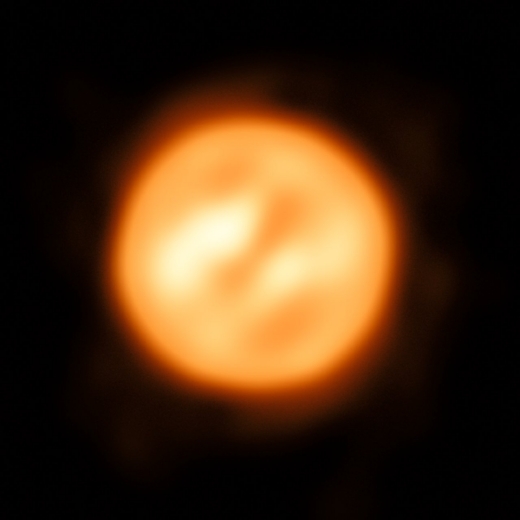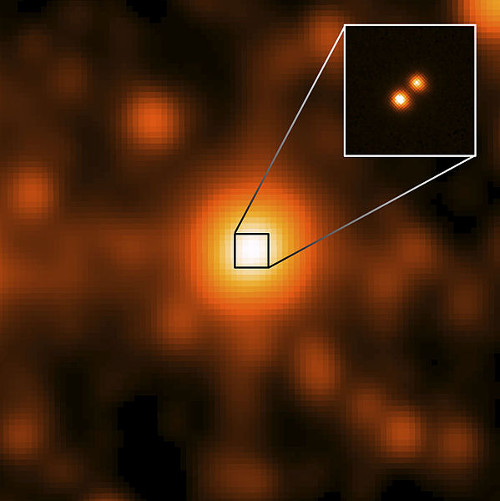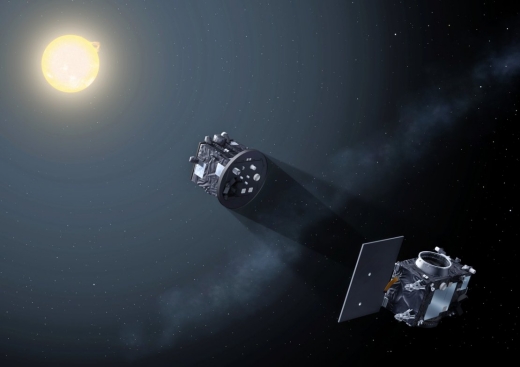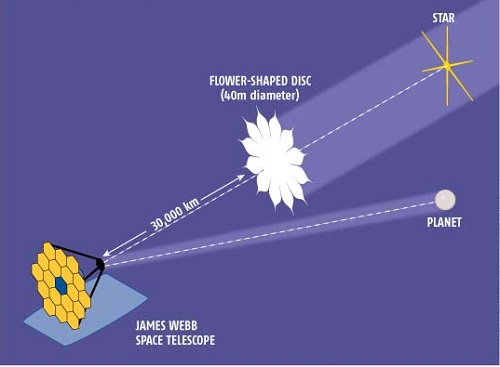Centauri Dreams
Imagining and Planning Interstellar Exploration
Deep View of Antares
Red supergiants are stars more massive than 9 times the mass of the Sun, a late stage of stellar evolution in which the stars’ atmospheres become expansive, while lowering in density. Antares, the brightest star in the constellation Scorpius, is about 12 times as massive as the Sun, but its diameter is 700 times larger. Its mass was once thought to be 15 times that of the Sun, with three solar masses of material being shed during its lifetime. If located in our Solar System, its outer edges would reach somewhere between the orbits of Mars and Jupiter.
Now we have word that scientists using the European Southern Observatory’s Very Large Telescope Interferometer (VLTI) at Paranal Observatory in Chile have been able to map the surface of this star, and to measure the motion of its surface material. What we get out of all this is the best image of the surface and atmosphere of any star other than our own.

Image: VLTI reconstructed view of the surface of Antares. Credit: ESO.
Lead author Keiichi Ohnaka and colleagues were able to create a two-dimensional velocity map of Antares’ atmosphere, using three of the VLTI’s auxiliary telescopes — these are 1.8 meter instruments that feed the interferometer and can be moved from place to place on the VLT platform. The VLTI can combine the light of four different telescopes, using either its 8.2 meter ‘unit’ instruments or the smaller auxiliary telescopes. In this case, three of the auxiliaries were complemented by AMBER, a near-infrared spectro-interferometric instrument.
With the help of the latter, the team was able to make separate images of the surface of Antares over a small range of infrared wavelengths. The ensuing map of the relative speed of atmospheric gases across the Antares disk grew out of calculations revealing the speed differential between gas at different positions on the star, and the average speed of gas over the entire star.
We’d like to know more about how supergiants like Antares lose mass as they enter their final stages. The paper reveals that the distribution of turbulent low-density gas was unexpectedly complex. Its presence much further from the star than predicted could not be explained by convection, which involves the transfer of energy from the core to the outer atmosphere of many stars — the extended atmosphere is much larger than convection models can produce.
From the paper:
Since convection alone cannot explain the density and extension of the atmosphere, some yet-to-be identified process should be in operation to make the atmosphere extended and give rise to the turbulent motions and also perhaps the mass loss. Given that we did not detect a systematic outflow within 1.7 stellar radii, the substantial acceleration of mass loss should take place beyond this radius. The next challenge remains to identify the driving mechanism responsible for the observed turbulent motions.
Thus we move toward applying these techniques to different types of star, now that we have demonstrated the ability to study stellar surfaces and atmospheres in such detail.
And if you’re looking for an Antares reference in science fiction, it would be to the classic Alfred Bester tale The Stars My Destination, in which protagonist Gully Foyle ‘jaunts’ (teleports) into the system (one of many in which he pops up), to find the star “…encircled by two hundred and fifty planetoids of the size of Mercury, of the climate of Eden.” Work that out if you can. And if you haven’t read Bester yet, this one needs to be at the top of the reading stack.
Today’s paper is Ohnaka et al., “Vigorous atmospheric motion in the red supergiant star Antares,” Nature 548 (17 August 2017), 310-312 (abstract).

‘Diamond Sky’: Remembering The Cosmic Connection
Looking at recent headlines about ‘diamond rain’ on Neptune provoked a few thoughts about headline writers, though the image is certainly striking, but then I recalled that Carl Sagan used to enjoy pulling out the stops with language as much as anyone. Listen, for example, to the beginning of his 1973 title The Cosmic Connection:
There is a place with four suns in the sky — red, white, blue and yellow; two of them are so close together that they touch, and star-stuff flows between them.
I know of a world with a million moons.
I know of a sun the size of the Earth – and made of diamond.
There are atomic nuclei a mile across that rotate thirty times a second.
There are tiny grains between the stars, with the size and atomic composition of bacteria.
There are stars leaving the Milky Way. There are immense gas clouds falling into the Milky Way.
There are turbulent plasmas writhing with X- and gamma rays and mighty stellar explosions.
There are, perhaps, places outside our universe.
And so on. The Cosmic Connection was long on language and imagination, and in its day, ideal for bringing the findings of astrophysics to the attention of the general public. Back in 1973, when I wasn’t poring over medieval texts, I kept the book nearby and re-read various chapters, enjoying Sagan’s effusive enthusiasm. I can see him adding a line or two about the latest findings on the interior of ice giants like Neptune and Uranus, with his own poetic twist.
And diamonds raining down from a high-pressure ‘sky’ deep in Neptune’s atmosphere to the dark core beneath certainly create a striking image. They’re suggested by a new paper looking at the chemical processes going on inside such worlds, which has demonstrated a way of creating what the researchers call ‘nano-diamonds,’ carbon atoms compacted into useful objects we may one day use in everything from medical procedures to industrial cutting needs. Nano-diamonds are likely paralleled by much larger diamonds in planetary interiors.
Having a magical image translated into practical science — and with real-world applications to boot — makes this story the kind of attention-grabber Sagan would have loved. The work involves an international team led by Dominik Kraus (Helmholtz Zentrum Dresden-Rossendorf), with experiments taking place at the SLAC National Accelerator Laboratory in Menlo Park, CA.

Image: By conducting experiments at the Linac Coherent Light Source — one of the world’s most powerful X-ray lasers — an international team of researchers led by HZDR physicist Dr. Dominik Kraus was able to demonstrate that hydrocarbon compounds split into carbon and hydrogen inside ice giants such as Neptune, shown here. The carbon turns into a “diamond shower.” Credit: Greg Stewart / SLAC National Accelerator Laboratory.
The ice giants of our outer system – and doubtless in other systems – contain solid cores thought to be surrounded by different ices — hydrogen molecules connected to lighter elements. What Kraus and colleagues wanted to do was to simulate the environment 8000 kilometers down, where high pressure produces diamonds that fall as precipitation deep into the interior.
The environment inside an ice giant was simulated by creating shockwaves in plastic using an optical laser beam at the Matter in Extreme Conditions (MEC) instrument at SLAC’s Linac Coherent Light Source (LCLS). Carbon atoms in the original plastic emerged as part of nanometer-scale diamond structures. On Uranus or Neptune, the researchers believe, such diamonds would be considerably larger and would eventually sink to the planet’s core.
The polystyrene used in the experiments is made from a mixture of hydrogen and carbon, and is used to simulate compounds formed from the methane that gives Neptune its distinctive color. Deep below the clouds of the ice giants, methane forms carbon and hydrogen chains that respond to the high pressure further down by forming the kind of diamond rain observed.
At SLAC, the optical laser created pairs of shock waves in the plastic which, when overlapping, produced the pressure needed to form the diamonds. At this point, the reaction could be probed with 50 femtosecond X-ray pulses from the LCLS, a kind of X-ray snapshot of the reaction.
“For this experiment, we had LCLS, the brightest X-ray source in the world,” said Siegfried Glenzer, professor of photon science at SLAC and a co-author of the paper. “You need these intense, fast pulses of X-rays to unambiguously see the structure of these diamonds, because they are only formed in the laboratory for such a very short time.”
The phenomenon is fascinating enough on our own ice giants, but the work has interesting implications for exoplanets because better models of planetary interiors can change the way we evaluate the relationship between mass and radius. The researchers believe the infall of diamond rain could also prove to be an additional heat source as it approaches the core.
The SLAC work goes beyond earlier attempts to simulate the formation of diamonds in ice giants by capturing measurements in real time, a feat made possible here through the combination of the optical lasers at MEC combined with X-ray pulses from the LCLS. We wind up with a glimpse of high-pressure diamond formation that agrees with theory and gives us further insight into the conditions inside planets like these. And conceivably, the clumping behavior of matter observed in this and other matter compression studies could give us better insight into the fusion of forms of hydrogen into helium, a process we’ve yet to master.
Sagan’s diamond star? “Some white dwarfs are largely carbon,” he writes in The Cosmic Connection. “We may speak of a star made of diamond.” Not quite the same phenomenon as a rain of diamonds on Neptune, though he does go on to quote Bob Dylan’s “To dance beneath the diamond sky / With one hand waving free,” a poetic stretch we can still enjoy whether it’s raining or not.
The paper is Kraus et al., “Formation of diamonds in laser-compressed hydrocarbons at planetary interior conditions,” published online by Nature Astronomy, 21 August 2017 (abstract).

Getting Ready for TVIW 2017
I’ve spent part of each day recently working on a short presentation I’ll be giving at the Tennessee Valley Interstellar Workshop, coming up in early October. I like this year’s motto — “Step by Step: Building a Ladder to the Stars” — because it picks up on a theme I’ve cited here before, the maxim by Lao Tzu that “You accomplish the great task by a series of small acts.”

Despite its regional name, TVIW now draws speakers from all over the world. Co-founder Les Johnson encapsulates the idea behind the sessions, emphasizing the workshop concept:
“The Tennessee Valley Interstellar Workshop is an opportunity for relaxed sharing of ideas in directions that will stimulate and encourage Interstellar exploration including propulsion, communications, and research. The ‘Workshop’ theme suggests that the direction should go beyond that of a ‘conference’. Attendees are encouraged to not only present intellectual concepts but to develop these concepts to suggest projects, collaboration, active research and mission planning. It should be a time for engaging discussions, thought-provoking ideas, and boundless optimism contemplating a future that may one day be within the reach of humanity.”
Image: TVIW co-founder Les Johnson.
My talk will address the question of astrobiological markers in planetary atmospheres, given as part of what TVIW is calling their ‘Sagan Meetings.’ As I understand the format, each of the four speakers has the floor in turn, and then the speakers form a panel that engages in discussion on the topic with the audience. In addition to my biosignature session, there will be a Sagan session on ‘Flyby or Deceleration’ and one on gravitational lensing possibilities at 550 AU. I’m hoping Claudio Maccone will be there for that one to discuss his FOCAL mission.
There is still time to sign up for TVIW 2017, which runs from October 3 to 6 in Huntsville, AL. This year the TVIW organization is joined by Starship Century and the Tau Zero Foundation as co-sponsors, each taking charge of a single day.

Given the number of people who’ve been asking me about updates on Breakthrough Starshot, the meeting should be productive, as Starshot executive director Pete Worden will be there along with other key figures from the project including Jim Benford, Kevin Parkin (Parkin Research), Philip Lubin (UC-Santa Barbara) and Robert Fugate, who chairs the subcommittee responsible for the all-important laser array to drive the craft. Highlights will be key progress in the program and procurements that are beginning to get underway on phased lasers, sail materials and sail dynamics.
Image: Breakthrough Starshot executive director Pete Worden.
The gravitational lens and its prospects gets several nods in this year’s TVIW, as JPL’s Slava Turyshev talks about the prospects of using gravitational lens technologies for communications and imaging. We’ll also have a reality check on the whole concept from Geoff Landis (NASA Glenn). And on the matter of data return, David Messerschmitt (UC-Berkeley) will be taking on related issues like limited available energy, transmit and receive antennas, pointing accuracy, and speed as he describes the plan to return data from a fleet of chip-like star probes.

Tau Zero founding architect Marc Millis will be describing the uses to which the foundation is putting its recent NASA grant, while Gerald Jackson will offer a look at antimatter fuel production. He will be joined by Tau Zero board chairman Jeff Greason (Agile Aero). Greg Matloff (CUNY), author of The Starflight Handbook among so much else, has just let me know that he will be sitting in on several of the panel discussions. Andrew Siemion (UC-Berkeley), one of the leaders of the Breakthrough Listen initiative, should offer insights into where SETI is going and the status of the Listen project. All in all, the roster of speakers is too long to list in its entirety and I’ll send you to the current schedule to see it.
Image: Tau Zero founder Marc Millis.
As we’ve done before at TVIW, the sessions will occasionally break for ‘working tracks’ on issues like SETI, security and the steps needed to build a starfaring civilization. These afternoon sessions have been helpful in the past because participants are asked to produce a report that can be read back to the entire meeting, thus concentrating focus and guiding discussion. I should also note a panel discussion that will include congressman John Culberson (R-TX) in the mix, a proponent of deep space exploration who offers a practical political perspective.
See the TVIW 2017 page for accommodations and other details. A number of science fiction authors, including the aforementioned Geoff Landis as well as Larry Niven and Allen Steele, will be coming for a post-conference event on the 6th. Hope to see you there as well.

New Findings on Brown Dwarf Atmospheres
I often think of brown dwarfs in terms of the planets that might form around them, and the question of whether even these small ‘failed stars’ may be capable of sustaining life. Have a look, for example, at Luhman 16AB, two brown dwarfs in the Sun’s immediate neighborhood. There are some indications of a planet here which, if it were ever confirmed, would make it the second closest known exoplanet to the Earth, at least for now. We can rule out planets of Neptune mass or greater with a period of between one and two years, but future Hubble observations, already approved for August of next year, may tell us more.

Image: Luhman 16AB, two brown dwarfs in the Sun’s neighborhood. Credit: NASA / JPL / Gemini Observatory / AURA / NSF.
But brown dwarfs, incapable of fusing chemical elements, have their own planetary characteristics. It’s this intriguing aspect of this population that gives us a kind of bridge to exoplanet systems, because brown dwarfs are often found alone, without a bright nearby star to hinder observations.
Thus we get a new paper from Daniel Apai (University of Arizona) and colleagues that looks at the weather on brown dwarfs, finding it to be similar in some ways to what we have seen on gas giants both in our own Solar System and elsewhere. And in some ways not.
Apai’s team used the Spitzer space telescope to monitor six brown dwarfs over the space of a year, observing each of them through 32 full rotations. Brightness changes are apparent as a brown dwarf rotates, due to its clouds varying throughout the atmosphere. The study of these brightness variations allows us to get a sense of how these hot clouds — largely thought to be made up of iron droplets and silicate dust — are distributed.
We already knew that brown dwarfs tend to have atmospheric storms, and it seemed reasonable to relate these to what we see on Jupiter in the form of storms like the Great Red Spot. For that matter, we can also find analogs on the other outer planets, from Saturn through Neptune, even if the kinds of clouds we find on Neptune, for example, are made of ice. And yet the brightness variations the researchers found were far more rapid than expected, with changes evident over the course of a single Earth day. That meant the model needed adjustment, at least when we move beyond Jupiter into the realm of more massive objects.

Image: This artist’s concept shows a brown dwarf with bands of clouds, thought to resemble those seen at Neptune and the other outer planets. Credit: NASA/JPL-Caltech.
The paper in Science describes the team’s work with a supercomputer and a new computer algorithm that creates maps of how clouds travel on brown dwarfs. Emerging from this is a model that involves variations in large waves moving through the atmosphere at different rates. We get, in other words, a different pattern than we see in elliptical storms like the Great Red Spot, which has persisted for centuries and changes little. On brown dwarfs, we move to the rapid propagation of waves in short time periods.
Theodora Karalidi (University of Arizona), who performed the supercomputer work on this model, says that it can explain how clouds travel on these objects:
“When the peaks of the two waves are offset, over the course of the day there are two points of maximum brightness,” Karalidi said. “When the waves are in sync, you get one large peak, making the brown dwarf twice as bright as with a single wave.”
What intriguing objects these are. Free floating brown dwarfs can be roughly the same diameter as Jupiter but far more massive, with atmospheres made up mostly of hydrogen and helium. Their cloud distribution in atmospheric bands and waves has similarities to our gas giant planets, but now we see just how changeable their cloud patterns can be in short time-frames. Thickening and thinning in a matter of hours, these hot clouds can change quickly while remaining confined to bands in different latitudes in which they move at different speeds.
Thus the brown dwarf lives up to its reputation as being something of a cross between a star and a giant planet, giving us its own unique atmospheric signature. Unlike the frenzied activity of a stellar atmosphere, brown dwarf atmospheric winds fall into regular belts and zones. But unlike the gas giants we are familiar with, they are in a state of rapid agitation and change.
Much work remains to be done, as we’re a long way from understanding the drivers of these waves. The paper is Apai et al., “Zones, spots, and planetary-scale waves beating in brown dwarf atmospheres,” Science Vol. 357, Issue 6352 (18 August 2017), pp. 683-687 (abstract).

The Future of Eclipse Science
Talk about transit depth! Those of you in the path of totality are fortunate indeed as we see just how deep a light curve can get. I’ve never experienced totality and won’t this time, but we’ll get plenty of good science out of this event and a spectacular 160 seconds for those in the path.
As the Sun’s corona is revealed, think about the solar wind — the stream of charged particles flowing from the corona out to the heliosphere — and how we might one day use similar stellar winds to brake the onrush of an interstellar probe with a magsail as it nears destination.

Image: The Moon’s shadow will dramatically affect insolation — the amount of sunlight reaching the ground — during the total solar eclipse. Credit: NASA’s Scientific Visualization Studio
160 seconds of totality is a fleeting but, so I’m told, haunting experience. For scientists, though, we’d like a good bit more. Thus it’s welcome news that the European Space Agency is working on Proba-3, a duo of small satellites designed to interact with each other to block the solar disk over and over again. The camera satellite and disk satellite engage in precision flying, creating artificial eclipses of six hours each time the two craft make one 19.6 hour orbit.
You would think that using a coronagraph to block out the direct light of the Sun would be sufficient, and such techniques are in use both on the ground and in space — the Solar and Heliospheric Observatory (SOHO) has been working with a coronagraph since 1996. But inserting a disk into the instrument to block out sunlight has its limitations. Andrei Zhukov (Royal Observatory of Belgium) is principal investigator for Proba-3’s coronagraph.
“The inner extent of the view afforded by standard coronagraphs is limited by stray light. Stray light is a sort of light pollution inside an instrument. In coronagraphs it is a kind of bending of the sunlight around the blocking disc. This problem can be minimised by extending the coronagraph length, the distance between the camera and the disc, as far as possible – but there are practical limits to coronagraph size. Instead, Proba-3’s coronagraph uses two craft: a camera satellite and a disc satellite. They fly together so precisely that they operate like a single coronagraph, 150 m long.”

Image: Proba-3 satellites form artificial eclipse. Credit: ESA.
Does this kind of precision flying remind you of anything? The use of an occulter craft flying in formation with a second satellite brought the ‘starshade’ concept to mind when I first encountered it. The 150-meter distance between the two Proba-3 craft is much smaller, of course, as 50,000 kilometers separate starshade and telescope in some concepts.
But the idea is similar — to find a way of blocking out the light of a star so as to reveal nearby space. A starshade would give us the opportunity to actually see exoplanets around nearby stars, light which we can then analyze to understand the composition of their atmospheres. In both concepts, the key is precise positioning and maintenance of the geometry through sensors and software. Missions like Proba-3 thus become not only useful scientific probes but likewise early tests of the kind of hardware we will one day use for close-up views of exoplanets.

Image: A starshade blocks out light from the parent star, allowing the exoplanet under scrutiny to be revealed. Credit: University of Colorado/Northrup Grumman.
For more on starshades, see Ashley Baldwin’s WFIRST: The Starshade Option, which looks at how we might use the technology with NASA’s Wide-Field Infrared Survey Telescope. Ponder this: The superb coronagraph that will fly aboard WFIRST will be a thousand times more powerful than anything now in operation, according to an essay by JPL’s Jason Rhodes.
But WFIRST with a starshade could reach contrast ratios 10,000 times greater still. Let me quote Rhodes on the matter:
The Starshade would have to be large, about 25-40 m across for a telescope the size of WFIRST, and even larger for a bigger space telescope that could follow WFIRST, and would fly 30,000-50,000 km away from the telescope. Building a structure that large and doing the precision flying needed to align the telescope and Starshade are no small tasks, but some of our best minds are on it. The peculiar ‘flower with petals’ shape of the Starshade is to deal with the diffraction of light. A circular Starshade would cause some of the star’s light to be bent (via diffraction) directly into the telescope. However, the petals are designed to diffract the light away from the telescope, allowing us to reach that magic 10 billion to 1 contrast ratio.
The artificial eclipses made possible through a starshade are very much on the mind of the astronomical community as the idea matures. So as you enjoy today’s eclipse, consider how critical ‘eclipse science’ will become as we analyze the atmospheres of distant worlds.

Laser SETI Funded
The SETI Institute’s Laser SETI campaign made it past the finish line. Many thanks to the many Centauri Dreams readers who helped to make this happen. All sky, all the time SETI should produce astrophysical discoveries we haven’t imagined, and of course we’ll keep hoping for that intriguing transient that turns out to point to extraterrestrial intelligence. Exciting times ahead!



